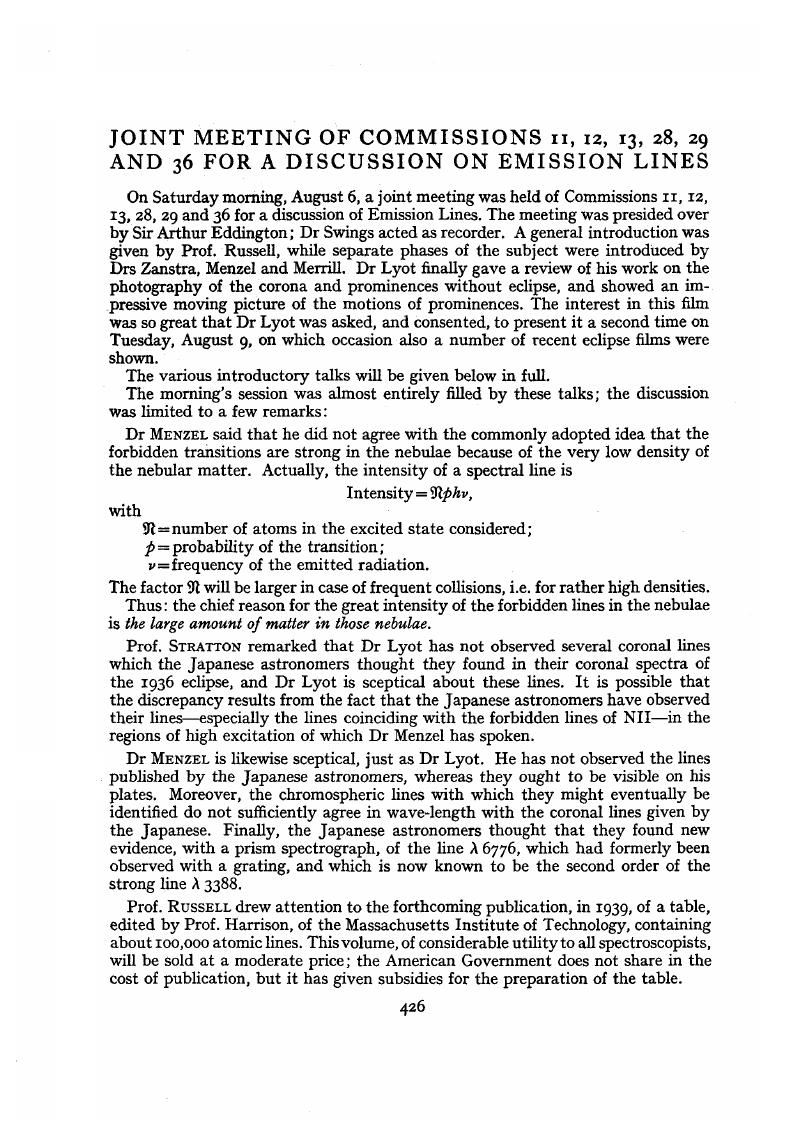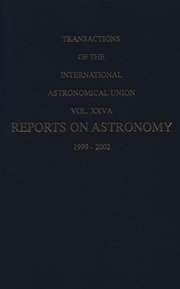No CrossRef data available.
Article contents
Joint Meeting of Commissions 11, 12, 13, 28, 29 and 36 for a Discussion on Emission Lines
Published online by Cambridge University Press: 25 April 2016
Abstract

Information
- Type
- Part IV Meetings of Commissions
- Information
- Copyright
- Copyright © International Astronomical Union 1976 1939
References
page no 429 note * In the case of nebulae in particular Hubble and the Lick observers, and for the novae Halm, Beals, Menzel, Mrs Payne Gaposchkin and others.
page no 430 note * Bowen, I. S., Ap. J. 81, 1, 1935 CrossRefGoogle Scholar.
page no 431 note * Zanstra, H., Publ. D.A.O. 4, 209, 1931 Google Scholar; Z.f. Ap. 2, 1, 1931.
page no 431 note † Berman, L., Lick Obs. Bull. No. 430, 1930 Google Scholar.
page no 431 note ‡ Page, T. L., M.N. 96, 604, 1936 Google Scholar; Comm. Univ. Obs. Oxford, No. 7.
page no 431 note § Cillié, G. G., M.N. 96, 771, 1936 Google Scholar.
page no 431 note ‖ Page, T. L., Nature, 141, 1137, 1938 CrossRefGoogle Scholar.
page no 431 note ⁋ The only similar case is that of Nova Aurigae 1891, as was e.g. pointed out by Beer (M.N. 95. 538 1935)> who refers to the light curve of Campbell (Harv. Ann. 84, 153, 1920, Fig. 1).
page no 432 note * Kosirev, N. A., M.N. 94, 430, 1934 Google Scholar.
page no 432 note † Chandrasekhar, S., M.N. 94, 444, 1934 Google Scholar; Proc. Camb. Phil. Soc. 31, 390, 1935.
page no 432 note ‡ McLaughlin, Cf. D. B., Publ. Am. Astr. Soc. 8, 145, 1935 Google Scholar; Publ. Univ. of Mich. Obs. 6, 107, 1937; Beer, A., M.N. 96, 236, 1936 Google Scholar.
page no 432 note § Russell, H. N., Publ. A .S.P. 48, 32, 1936 CrossRefGoogle Scholar.
page no 432 note ‖ Williams, E. G., M.N. 95, 573, 1935 Google Scholar.
page no 432 note ⁋ Chandrasekhar discusses also some other values of the exponent.
page no 432 note ** Whipple, F. L. and Gaposchkin, C. Payne, Harv. Circ. No. 412, 1936 Google Scholar.
page no 432 note †† Cecchini, G. and Gratton, L., Mem. d. classe di sc. phys. math. e nat. Reale Accademia d’Italia, 8, 654, 1937 Google Scholar.
page no 433 note * Grotrian, W., Z.f. Ap. 13, 215, 1937 Google Scholar; Z.f. Techn. Phys. 18, 146, 1937.
page no 433 note † Oehler, H., Z.f. Ap. 12, 281, 1936 Google Scholar.
page no 433 note ‡ Oehler obtained this from the ratio He+/H according to Ambartsumian. From the rise of 13m·1 to 6m·7 one finds that the difference in visual magnitude of star and “nebula” m *—m n≥6·4, or ≥ 5·9. if the photographic magnitude is used for the star, colour index – 0·5. Then Z. f. Ap. 2, 26, 1931, Table 6, yields T ≥ 70,000°. This confirms the high temperature.
page no 433 note § As Grotrian remarks, it would be easy to force an agreement, e.g. by assuming an electron temperature of 50,000°.
page no 434 note * The transition 2, 1 between a singlet and a triplet level (intercombination line) is less probable than the transition 3, 2 between two singlet levels.
page no 434 note † Bowen, I. S., Phys. Rev, 36, 600, 1930 CrossRefGoogle Scholar.
page no 434 note ‡ Menzel, D. H. and Payne, C. H., Proc. Nat. Ac. Sc. 19, 641, 1933 CrossRefGoogle Scholar.
page no 434 note § Menzel and Payne, loc. cit. The predominance of auroral transitions in novae as compared with nebular transitions in nebulae was first explained in this manner by Grotrian for [OIII] and [OI], Z.f. Phys. 60, 302, 1930; Z.f. Ap. 2, 78, 1931.
page no 434 note ‖ Dufay, J. and Bloch, M., Z. f. Ap. 13, 36, 1937 Google Scholar.
page no 434 note ⁋ Since the time was rather limited, the following paragraph discussing the other bright lines was not read at the Stockholm meeting.
page no 439 note * Ap. j. 78, 87, 1933.

